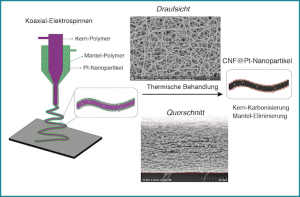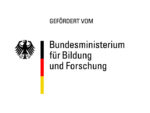FASER-KAT
Self-supporting, structured, electrospun carbon nanofiber nonwoven material acting as high-performance catalyst layers in PEM fuel cells (FASER-KAT).
The aim of the project is to increase the performance and durability of polymer electrolyte membrane fuel cells (PEMFC). For this purpose, a novel self-supporting, structured, electrospun carbon nanofiber fleece-based catalyst layer (RZ) is used.
Such free-standing catalyst layer materials are expected to increase the electrical and thermal conductivity of the PEMFC reactive zone (RZ). In addition, platinum (Pt) utilization is maximized, ionomer occupancy is minimized, and reactant diffusion and electrode durability are significantly improved.
The combination of advanced fabrication methods for the catalyst support structures (electrospinning, oxidation, carbonization) in combination with bicomponent (BiKo) spinning of the nanofiber ensures that the Pt catalysts are located in the “sheath” of the nanofibers. In addition, as an alternative, subsequent deposition methods for Pt-NP – by means of Pt reduction or application of Pt colloid to carbon nanofiber nonwovens will be carried out.
The production of the carbon nanofibers (CNF) or the 3D CNF structures and the platinization of these are optimized with respect to maximum electrochemical performance and durability of the RZ as well as process scalability – prospectively as large-scale production.

Figure 1: General operation of a spinning stand for electrostatic spinning of nanofibers (left), Pt/CNF nonwoven (middle), reaction process of CNF synthesis (right).
The novel manufacturing approach offers the following advantages over a conventional standard RZ:
– Fabrication of a self-supporting Pt-containing carrier precursor in one step by electrospinning.
– Downstream carrier carbonization, complete decomposition of the cladding polymer and, if necessary, reduction of the Pt precursor in a thermal process, optimization by:
– Control of catalyst deposition by core-sheath electrospinning.
– If necessary, coating of CNF with Pt-NP after CNF support carbonization.
– Adjustable fiber size, orientation and bonding, nonwoven density of the layer and thus also of the subsequent catalyst layer, and adjustment of the degree of carbonization
– Targeted optimization of electrical, thermal and electrochemical RZ properties:
– Increase of the electrical and therm. Conductivity of the nonwoven or the RZ due to the 2D expansion (aspect ratio) of the substrate and adapted 3D structure of the interconnections, thus reducing losses and increasing the efficiency
– Material-related increase in corrosion resistance due to increased degree of carbonization and thus higher carbon content
– Carrier surface area increase (up to 1000 m2g-1) for Pt-NP
– Scalable manufacturing process – can be implemented as multi-nozzle electrospinning or centrifugal electrospinning – with great potential for roll-to-roll RZ large-scale production
– Electrospinning as an RZ manufacturing process – due to the relatively simple set-up and no high investment – can be implemented and realized by SMEs in the short term.
Titel: Selbsttragende, strukturierte, elektrogesponnene Kohlenstoffnano-faservlies basierte Hochleistungs-Katalysatorschichten für PEM-Brennstoffzellen
Key-Word: FASER-KAT
Funding Code: 22598 N
Runtime: 01.09.2022 bis 28.02.2025
Project-Partner: Deutsches Textilforschungszentrum Nord-West gGmbH, Krefeld
Zentrum für Brennstoffzellentechnik GmbH (ZBT), Duisburg
Contact DTNW: Dr. Andreas Wego, Tel.: +49-2151-843-2017, E-Mail: wego@dtnw.de




